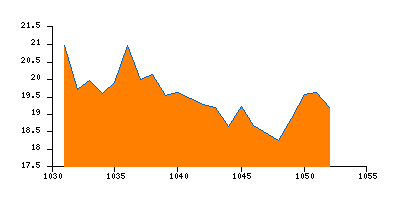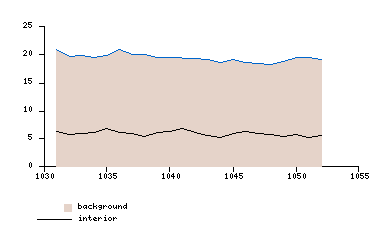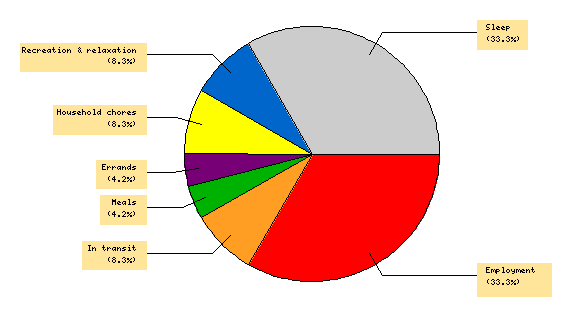 Search
Search
Ploticus >
Prefabs >
| Ploticus prefabs examples gallery |
This page is a collection of all of the ploticus
prefab
examples.
These examples all use
the chron prefab.
All of these examples are included in the distribution (./pltestsuite/testpf_chron).
chron example 1 - dates
pl -prefab chron data=data14 x=1 y=2 datefmt=yy/mm/dd xinc="1 month" \\
stubfmt=M xyears=yyyy yrange="0 25" barwidth=line color=red \\
title="# hits per day" omitweekends=yes
The data14 file:
00/12/21 1
00/12/22 1
00/12/23 2
00/12/27 1
chron example 2 - dates - tabulated by week
pl -prefab chron data=data14 x=1 y=2 datefmt=yy/mm/dd xinc="1 month" \\
stubfmt=M xyears=yyyy color=green tab=week title="# hits per week"
chron example 3 - dates - tabulated by week
pl -prefab chron data=data19 x=2 y=1 datefmt=mmddyy xinc="1 month" \\
stubfmt=M xyears=yyyy color=green tab=week include2=annot \\
title="# website visitors per week" rectangle="1 1 4 2.5" ygrid=yes \\
mode=line step=yes fill=red
The data19 file:
18 071301
16 071401
15 071501
34 071601
In the above example, notice that rectangle (new in 2.02) was used to set a smaller
size, and a file containing script code for the annotation is included.
chron example 4 - dates - tabulated by month
pl -prefab chron data=data14 x=1 y=2 datefmt=yy/mm/dd xinc="1 month" \\
stubfmt=M xyears=yyyy color=powderblue tab=month tabmode=first \\
nearest=month barwidth=0.2 curve=yes
chron example 5 - datetimes - tabulated by hour
pl -prefab chron data=data16 x=1 tab=hour datefmt=yy/mm/dd xinc="1 day" \\
barwidth=line stubfmt=MMMdd unittype=datetime timefld=2 \\
title="# hits per hour"
The data16 file:
01/09/05 09:43:35
01/09/05 09:43:40
01/09/05 13:15:00
01/09/05 13:15:11
Note that a file such as this (data13) could also be used, and timefld
would not need to specified:
01/09/05.09:43:35
01/09/05.09:43:40
01/09/05.13:15:00
01/09/05.13:15:11
chron example 6 - times - tabulated by hour
pl -prefab chron data=data15 x=1 tab=hour unittype=time xinc="1 hour" \\
nearest=hour barwidth=0.2 stubfmt=HHA \\
title="# events per hour" color=coral
The data15 file:
07:47:49
07:47:52
07:47:54
chron example 7 - hourly temperature readings plotted for one week
pl -prefab chron data=data22 header=yes x=1 y=2 datefmt=mm/dd/yyyy \\
xinc="1 day" mode=line unittype=datetime title="temperatures this week"
The data22 file has data for one week and begins like this:
datetime temp
12/08/2002.00:00 22
12/08/2002.06:00 24
12/08/2002.12:00 31
12/10/2002.00:00 30
chron example 8 - multiple curves
pl -prefab chron data=data24 header=yes unittype=datetime mode=line\\
datefmt=mm/dd/yyyy x=dt y=airtemp y2=soiltemp y3=watertemp \\
xinc="1 day" legendfmt=singleline
The data24 file looks like this:
dt airtemp soiltemp watertemp
12/08/2002.06:00 24 27 16
12/09/2002.00:00 25 27 16
12/10/2002.00:00 30 27 15
12/11/2002.00:00 32 32 15
12/12/2002.00:00 40 37 16
12/13/2002.00:00 19 27 15
12/14/2002.00:00 14 18 13
In version 2.20 the ability to render multiple curves or bar sets was introduced.
This can be done so long as tabulation is not being performed.
These examples use
the cumufrac prefab
and are included in the distribution (./pltestsuite/testpf_cumufrac).
cumufrac example 1
pl -prefab cumufrac data=cumufrac.dat header=yes x=1 name="set 1" \\
x2=2 name2="set 2" title="Cumulative fraction plot"
The cumufrac.dat file looks like this:
set1 set2
1.26 2.37
0.34 2.16
0.70 14.82
1.75 1.73
50.57 41.04
cumufrac example 2
pl -prefab cumufrac data=cumufrac.dat header=yes logmode=log x=1 x2=2 \\
title="Cumulative fraction plot w/ log scale" \\
linedet="color=blue width=1.5" \\
linedet2="color=orange width=1.5 style=2 dashscale=3"
These examples all use
the dist prefab.
All of these examples are included in the distribution (./pltestsuite/testpf_dist).
dist example 1
pl -prefab dist fld=1 data=data6 curve=yes binsize=0.05 \\
barwidth=0.08 ygrid=yes
data6 file:
0.017
0.269
0.178
dist example 2
pl -prefab dist fld=1 data=data8 cats=yes yrange=0 \\
stubvert=yes barwidth=0.05 ylbl="# Hits" order=rev
data8 file:
home
kwindex
details
browseform
These examples use the
heatmap prefab
and are included in the distribution (./pltestsuite/testpf_heatmap).
heatmap example 1

pl -prefab heatmap data=curve1.dat y=1 x=2
The curve1.dat file looks like this:
331 75
331.624 83.5518
332.105 88.7758
332.492 91.8638
The heatmap prefab's basic mode is to count instances. Here, the bin sizes
in x and y are automatically determined, as is the breakdown for color coding.
Default color scheme is used.
These can all be given explicitly if desired.
In this example, both X and Y are numeric.
heatmap example 2

pl -prefab heatmap data=snpmap.dat header=yes y=1 x=2 ycats=yes xbinsize=5 \\
colorlist=white,limegreen,green,teal,blue,purple,black
Counting instances again. In this example X is categorical and Y is numeric, and
a user-supplied x binsize and color scheme was used. Y bin size and color breakdown
are automatically determined.
heatmap example 3

pl -prefab heatmap data=data26 x=1 xcats=yes y=2 ycats=yes contentfield=3 \\
outline="color=black width=5"
The data26 file looks like this:
CL PNG 44
CL SVG 38
CL SWF 26
CL PS 54
CGI PNG 37
In this example, instead of counting instances, a predetermined value (contentfield=3) is used
to set cell color. Both X and Y are categorical. The cells are separated by thicker
black lines.
heatmap example 4

pl -prefab heatmap data=data26 x=1 xcats=yes y=2 ycats=yes contentfield=3 \\
symbol="shape=circle radius=0.1" legendsep=0.2 zerocolor=white
Same as example 3 but circles are used for cells, and background is white.
These examples all use
the lines prefab.
All examples are included in the distribution (./pltestsuite/testpf_lines).
lines example 1
pl -prefab lines data=data17 x=1 y=2 pointsym=none
The data17 file:
331 75
331.624 83.5518
332.105 88.7758
lines example 2
pl -prefab lines data=data10 delim=tab x=1 y=2 y2=4 step=yes \\
yrange=0 name="Group A" name2="Group B" xlbl=Months
lines example 3
pl -prefab lines data=data10 delim=tab x=1 y=2 err=3 y2=4 err2=5 \\
y3=6 err3=7 y4=8 err4=9 yrange=0 xlbl=Months \\
name="Group A" name2="Group B" name3="Group C" name4="Group D"
The data10 file:
0 100 2 100 4 100 3 100 4
1.5 92 4 94 7 87 6 86 5
3 89 4 92 8 78 6 74 4
6 86 5 91 8 65 8 61 6
lines example 4

pl -prefab lines data=data20 x=1 y=2
The data20 file:
1031 20.96 6.4
1032 19.71 5.8
1033 19.98 5.9
lines example 5

pl -prefab lines data=data20 x=1 y=2 fill=redorange pointsym=none \\
y2=2 pointsym2=none
In this example the same data field was given twice, first to do the filled
area, and again to do the blue line.
lines example 6

pl -prefab lines data=data20 x=1 y=2 gapmissing=yes
lines example 7

pl -prefab lines data=data20 x=1 y=2 fill=tan1 pointsym=none \\
y2=2 pointsym2=none y3=3 pointsym3=none linedet3=color=black \\
yrange="0 25" name="background" name3="interior"
This example uses the
multidist prefab.
Example 1
pl -prefab multidist overlay=yes data=data21 rotate=yes \\
xrange="0 2000" yrange="0 20"
The data21 file is like this:
sample1 380 239 384 384 1220 888
sample2 778 870 398 499 1472
These examples use
the pie prefab.
They are included in the distribution (./pltestsuite/testpf_pie).
pie example 1
pl -prefab pie values=3 labels=1 data=data9 \\
delim=tab title="Student enrollment"
data9 file:
Business Admin 1.39 331
English 1.67 182
Chemistry 2.07 301
pie example 2
pl -prefab pie data=data23 delim=tab values=2 labels=1 colorfld=3 \\
title="Colors from data field" legend=yes
the data23 file:
Employment 8 red
In transit 2 orange
Meals 1 green
Errands 1 purple
Household chores 2 yellow
Recreation & relaxation 2 blue
Sleep 8 gray(0.8)
Colors driven by data, and a legend for explanation.
pie example 3

pl -prefab pie data=data23 delim=tab values=2 "labelfmtstring= @1\\n (@PCT%)"
colorfld=3 labelback=dullyellow firstslice=90 center="4 3" radius=1.5
Labels with backing boxes, and an explicitly defined center and radius.
These examples use the
scat prefab
and are included in the distribution (./pltestsuite/testpf_scat).
scat examples 1 & 2
Left: pl -prefab scat data=data1 x=2 y=3
Right: pl -prefab scat data=data1 x=2 y=3 id=1 \\
xlbl="Total Ch" ylbl="White Blood Cell Count" corr=yes
data1 file: A/J 1.39 331
BALB/cJ 1.67 182
C3H/HeJ 2.07 301
scat example 3
pl -prefab scat data=data3 x=2 y=6 err=3 xerr=7 corr=yes \\
ptshape=triangle ptsize=0.08 ptcolor=red "errcolor=gray(0.8)"
data3 file:
129S1/SvImJ 0.4927 0.111 0.353 129S1/SvImJ 0.4080 0.0839 0.265
A/J 0.5547 0.0768 0.243 A/J 0.6051 0.0656 0.207
AKR/J 0.4125 0.0631 0.200 AKR/J 0.3653 0.0418 0.132
scat example 4
Two different sets of data points are plotted using two different symbols, and error
bars are also generated.
The sets are selected using ptselect and ptselect2.
pl -prefab scat data=data25 delim=tab x=3 y=4 err=5 ptselect=" = A" xerr=6 \\
x2=3 y2=4 err2=5 ptselect2=" = B" xerr2=6
data25 file:
ABC A 5 4 2.5 2.3
ABC B 4 4.5 1.6 1.8
DEF A 8 9 1.8 1.5
DEF B 3 3 0.9 1.3
GHI A 7.7 6.5 1.2 0.6
GHI B 6.6 6.3 0.8 1.1
These examples use the
stack prefab.
They are included in the distribution (./pltestsuite/testpf_stack)
stack example 1 - bars
pl -prefab stack data=data10 x=1 y=2 y2=4 y3=6 y4=8 xlbl=Months \\
name="Group A" name2="Group B" name3="Group C" name4="Group D"
data10 file:
0 100 2 100 4 100 3 100 4
1.5 92 4 94 7 87 6 86 5
3 89 4 92 8 78 6 74 4
stack example 2 - a stacked area plot
pl -prefab stack data=data5 delim=tab x=1 y=2 y2=3 y3=4 y4=5 \\
stackarea=yes echodata=yes stubvert=yes \\
name=eastern name2=central name3=mountain name4=pacific
data5 file looks like this:
Test 4 83 12 64 9
Test 5 95 11 92 13
Test 6 42 8 76 11
Test 7 69 13 68 6
Test 8 76 19 84 14
Test 9 83 12 64 9
Test 10 95 11 92 13
Test 11 42 8 76 11
Test 12 69 13 68 6
These examples use the
vbars prefab
and are included in the distribution (./pltestsuite/testpf_vbars)
vbars example 1
pl -prefab vbars data=data4 delim=tab x=1 y=2 vals=yes\\
yrange=0 yinc=20 ygrid=yes barwidth=0.3
data4 file:
Group A 78 7
Group B 84 12
Group C 56 6
vbars example 2
pl -prefab vbars data=data5 delim=tab x=1 y=2 err=3 \\
y2=4 err2=5 errunder=yes ygrid=yes barwidth=0.1 \\
name=Treatment name2=Control stubvert=yes
data5 file:
Test 3 76 19 84 14
Test 4 83 12 64 9
Test 5 95 11 92 13
vbars example 3
pl -prefab vbars data=data5 delim=tab x=1 y=2 err=3 y2=4 \\
err2=5 erronly=yes name=Treatment name2=Control stubvert=yes \\
errcolor=red errcolor2=blue sep=0.08 xgrid=yes ylog=log
vbars example 4
pl -prefab vbars data=data18 x=1 y=2 crossover=0 \\
color=blue vals=yes
The data18 file:
1992 -47
1993 -63
1994 -24
1995 12
These examples use
the vdist prefab.
They are included in the distribution (./pltestsuite/testpf_vdist).
All examples use data from the data6 and data6b files having one
field containing several hundred numeric values.
vdist example 1
pl -prefab vdist data=data6 y=1
vdist example 2
pl -prefab vdist data=data6 y=1 mediansym=dot dist=hist \\
showoutliers=yes
vdist example 3
pl -prefab vdist data=data6 data2=data6b y=1 y2=1 dist=hist \\
title="Set 1" title2="Set 2"



